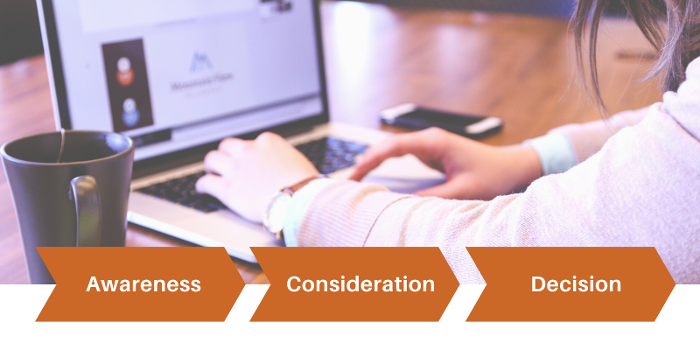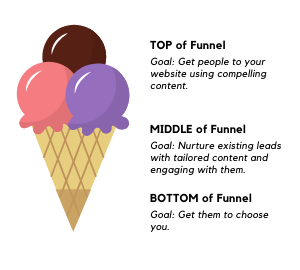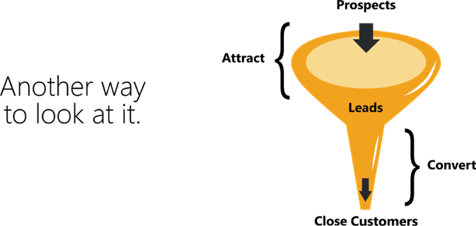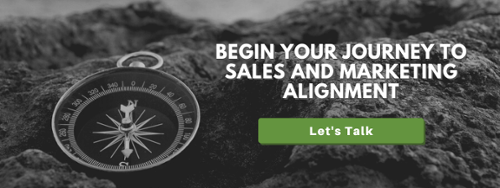
Lead Generation Sales Funnel for Industrial Companies
Ah, lead generation. A constant battle and love-hate relationship. You win some and you lose some. If you’re facing challenges generating leads, the good news is that you are not alone. In fact, many companies are facing these common challenges:
- Not enough leads
“61% of marketers say generating traffic and leads is their top challenge.” – HubSpot, 2018 - Not the right leads
“Only 18% of marketers say outbound practices provide the highest quality leads for sales.” – HubSpot, 2018 - Difficult to convert
“Only 5-10% of qualified leads successfully convert for marketers.” – Technology Marketing - Keeping them as customers
“Only 29% of brands nurture their existing customers beyond the initial purchase.” – Demand Gen
These are just some of the difficulties businesses face in their process of handling leads. Now yours may look different, but it’s important to define them in order to find the best strategy to correct the problem.
After looking at these challenges, we can see how beneficial a vital understanding of lead generation can be to a business. If executed poorly, it can have a huge impact on your sales revenues.
A lot of companies underestimate the value your website can have in generating leads. Consider the Buyer’s Journey when evaluating your website. The Buyer’s Journey is just the process buyers go through to become aware of, consider and evaluate, and decide to purchase a new product or service.
There are three stages of the Buyer’s Journey:
- Awareness – in this stage buyers are experiencing a need or issue and may be doing research to better define their problem or need
- Consideration– People in this stage have defined their need/problem and is actively researching the available approaches or methods to solving or satisfying their need.
- Decision– people in this stage have decided on their solution strategy and have started compiling a list of vendors or companies. This list will become shorter as they weed out those that don’t fit their intended solution until a final purchase decision is made

Notice a common theme in the awareness and consideration stages? Yes! I knew you’d see it and you’re right. Its research. In this digital day & age, the majority of research is done online.
What is a sales lead?
Now that we understand the Buyer’s Journey and the path the buyer takes to become a customer, it’s time to define what a sales lead is. Simply stated, it is anyone who has showed interest in your company or has engaged in some way. They could have visited your website, sent a request for a quote or just requested some basic information.
Now, the journey leads take as they interact with your business and vice versa is very important, and this is where an understanding of the Sales funnel is beneficial.
 Imagine your sales funnel much like this ice cream cone, wider at the top and thinner at the bottom. This illustrates how customers commonly flow through the funnel. Many leads are coming in through the top however, may not be ready to buy.
Imagine your sales funnel much like this ice cream cone, wider at the top and thinner at the bottom. This illustrates how customers commonly flow through the funnel. Many leads are coming in through the top however, may not be ready to buy.
This is more of an awareness stage where customers are just learning about your company, product, and/or service. Advertising, social media, word of mouth, and your company website are all common ways to attract these top of funnel leads.
Those in the middle and bottom of funnel are the leads you want to direct specialized attention to as they’ve moved beyond the awareness of your company and into interest and consideration. In other words, if they’ve click on a blog and read about a certain topic, it’s time to start sending them similar information.
A smaller percentage of those that are ready to convert into business will fall out the bottom into deals or sales. Attract those at the top, nurture those in the middle, and convert those closer to the end. There’s a reason those at the end are more willing to convert because they’ve made it this much further down the path. It’s called a Buyer’s Journey because buyers are truly taking a path towards your business.
This brings us to the definition of lead generation, or lead gen as it’s often referred to, is just the process of filling that sales funnel by using activities that engage people with your business. These activities are the tactics you deploy.
Define Your Customers
The first and foremost step of developing a good lead generation process is defining your customers.
Their demographics such as their age, gender, type of company and location. If you are the business to business selling space, you’ll want to identify the type of industry your customers are in, job title of targets, company revenue, and how long the company has been in business.
You’ll also want to consider their psychographics, and this will be how your customers shop whether it be online, catalogs, physical store visits and also where they go to find information is especially key because you are going to be the answer they want to find.
Identify the challenges or problems this customer may find on a daily basis. The value of your product or service will depend on how well it eliminates a problem or issue for the customer. Understanding these challenges help you better portray your product or service as a solution rather than a sale.
What is your Buyer Persona?
By defining these, you can create a Buyer Persona which is a semi-fictional representation of your ideal customer that is based off market research or data of your existing customers. This is semi-fictional in the sense that all your customers may not fit exactly into this Buyer Persona that you’ve created but most of them do.
For example, if I own a yoga studio, my buyer persona might be women between the ages of 20 and 30 who are either in school or just starting their professional careers. Most of them may live in the city or in a dorm like atmosphere.
Does that mean some of my customers aren’t 40-50 year-old men living in the suburbs? Not at all. But many of my customers, based on my examination of my existing customer base, are the younger women and I may tailor my main marketing message to that buyer persona. Keep in mind you could have several buyer personas depending on how many products or services you sell and the avenues in which you chose to sell them.
Where does your ideal customer hang out online?
Next there needs to be some definition on where these customers typically look for your products or services. If it’s online there are many sources to consider. For business to business companies, it could be the website along with some sort of automation or electronic way to keep track of all the contacts you are currently doing business with.
With the digital age, it’s important to stay front of mind on how you will leverage technology to fuel sales.
After all, “67% of the buyer’s journey is now done digitally.” –SiriusDecisions
That’s a hefty percentage, and you do not want to miss these people.
You could be a business who run mostly off of referrals.
Does your company attend events? Conferences or trade shows. These things all help make connections to further drive business. All of these things need to be taken into consideration when developing your outreach strategy.
What are the stages of the buyers’ journey?
Top of Funnel
Ok, so you’ve defined everything, and are ready to execute some tactics. This is the time where you would decide how you are going to capture your chosen audience.
If it’s a website, content geared to your ideal customer base (remember those buyer personas) will need to be created to attract them to your site. Keywords and good website development will be key here to make sure you rank high in the Google search results.
93% of all online experiences begin with a search engine. And Google is the Godfather. Making sure the website is mobile friendly is also extremely important.
Ensure your business’s website includes description of company, pictures of product or services, event information, etc.
There are many different channels for reaching your customer base, your company will need to decide the best fit for the clients they’ve defined. A lot of this will depend on how they search, shop, and buy.
Nurture: Middle of Funnel
So, you’ve captured their attention as leads and now as they transition to prospects, it’s time to nurture them. The strategy that you choose to implement will depend heavily on your company’s industry and targets.
In the B2B technical spaces, such as manufacturing and engineering industries, your website will be a key player in attracting leads. The use of blogs, eBooks, and whitepapers will help your potential customer see your company as an industry expert. Reviews and case studies can be especially important in validating your company’s services and products to the buyer. Make use of any engaging welcoming offers in ads, promotions, or on your website.
Use social media to promote your products. This can be Facebook posts, Twitter and LinkedIn. Consider what your ideal customer looks at based on the buyer personas you’ve outline earlier and use that knowledge to get the information in the most visible place for your prospects.
The important thing to note about the middle of funnel is that people have moved from the awareness stage and entered the consideration stage. Your goal here should shift from “Look at me!” to “Look what I can do.” Like mentioned before if they’ve sent a request for a quote, clicked on your website, or have given you their contact information, it’s time to start letting them know they’ve done it for a reason.
Convert: Bottom of Funnel
At this point, your lead knows you and is comfortable engaging with you. This is the time the sale is presented. Free trials or assessments can help with your more hesitant prospects. These will be assets to help persuade your prospects to become customers.
Nurturing these prospects AFTER they become a customer is also key. It’s important to keep the customers happy whether it be through specialized content or discount codes to encourage repeat purchases. All of these things can not only help complete the sale but encourage future sales. This can also help develop content for middle of funnel prospects through reviews and testimonials.

Analyze & Improve
You’ll work through your sales funnel and lead generation strategies several times with multiple customers, and as you do this, you’ll gather data each time. As these processes continue, you’ll have to ask yourself which tactics worked better than others. Were there pieces of content that stood out more for your customers than others? Were they engaging enough?
Your buyer persona’s may even change. The more you engage with your customers, the better idea you have of who you’re dealing with.
You’ll also want to keep track of the number of closed deals and total revenue based off your marketing efforts. It’s important to track this type of ROI as some of your marketing channels may have been more effective than others, find out why. You can decide whether you want to improve the weaker efforts or dedicate more time and resources to those that gave you the most sales.
You might find some tactics give you more leads with less conversions and may want to shift efforts in a different direction, although some tactics may produce less leads, they are of higher quality and therefore more likely to convert. This will all depend on your customer targets and your company resources. Determining which metrics to analyze will be vital to optimizing your sales conversions
There is no one size fits all when it comes to lead generation. It is really something that should be tailored to your business goals and your customer needs.
And each time around there will be new discoveries about way you can improve or redirect.
If you’re looking for more information on how your company can maximize its sales opportunities and increase revenue, reach out to us!



